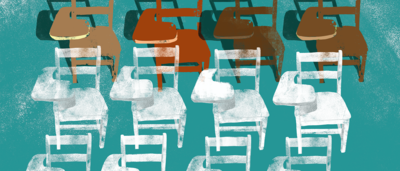In 2016, when Ryan T. Williams arrived as the new assistant principal at East Millbrook Middle School in Raleigh, North Carolina, he seemed like the perfect fit. The school was under investigation by the Office of Civil Rights due to disproportionate suspension rates for Black students. As an elementary teacher, Williams had done restorative work in his classroom for years.
But in his first year at East Millbrook, Williams admits, he “suspended a lot of students.” By year two, Williams said, suspension numbers were “stratospheric.” The school urgently needed to disrupt a culture based on harsh punishments that removed students from classrooms. Williams knew this, as did those who recruited him to the position. The open question was how.
“There was not a structure for me to implement [restorative] practices,” Williams says. “So I walked into that culture, and I kind of adhered to that culture because I didn’t really have anything else to lean on.
“So we had to come up with something better.”
Williams’ story resonates in an education system still reckoning with months of protests and activism that demanded an end to racist discipline systems. It resonates as students and families point to the ways those racist discipline practices have been maintained in virtual learning environments during the COVID-19 pandemic. In the past year, we’ve seen a commitment to change from schools across the country.
But truly restorative practices can’t be instituted overnight. They require a foundation of inclusion and trust—and experts say it’s vital that educators understand the steps, structural change and coalitions it takes to get there.
What Do We Mean by Restorative Practices?
According to the International Institute of Restorative Practices (IIRP), restorative practices, at their core, are about strengthening individual and community relationships to create a sense of belonging and provide a system of communal accountability that sets the stage for repairing harm that may arise from student or educator behavior.
That wasn’t the culture in place when Williams walked into East Millbrook. He says the culture there, at the time, was one that prioritized student compliance. In the Spring 2021 issue of Teaching Tolerance magazine, scholars and educators discuss how compliance has historically and presently been used in schools to exert control over—and demand assimilation from—students of color, particularly Black and Indigenous students. Tools of compliance, such as punitive discipline practices, dress codes and school security measures, enact harm on students. That harm, as the story illustrates, can be overt and obvious, or it can be more insidious.
Dr. Thalia González, a legal scholar who studies systemic harm and restorative practices, says that the common punitive culture of compliance in U.S. schools disproportionately drives BIPOC students into the criminal justice system and sustains cycles of poverty and opportunity gaps. It also drives negative health outcomes, even years later, for students who face repeated traumas, rejection, isolation or dehumanization.
The solution, she says, is to ask a key question: “How do we disrupt these drivers for young people that will continue to persist if we can’t get rid of, or at least purge to a large extent, this whole structure that is about social control of a particular set of bodies?”
For González, Williams and many others, restorative practices have a vital role to play in that restructuring.
These practices include restorative inquiry, restorative conferencing, and most famously, restorative circles—a broad term for group conversation that can be used proactively or after an incident, ultimately serving to provide a more equitable format for discussing critical topics or resolving community conflicts.
This resource provides several real-world examples of what restorative practices can look like in a school.
“In schools that use restorative and accountable discipline and student support, students necessarily take an active role,” Jill Davidson wrote for Teaching Tolerance magazine back in 2014. “Discipline is not something that is externally imposed. Instead, students engage in inquiry and must have a voice in determining next steps and consequences in a context of support, strong relationships and effective communication.”
Restorative practices, in essence, replace systems that impose punishment and top-down systems of control on students in favor of a more communal, collaborative system of communication, expectation-setting and accountability.
“We have these blanket rules that are fairly arbitrary, that do not allow for exceptions or complexities,” explains Victor Small, Jr. “I think that restorative justice gives you that. It gives you the ability to understand the complexity.”
A recent classroom teacher and administrator, Small organizes popular online chats on restorative justice, including one called the Restorative Justice League. Restorative practices do not work without social emotional awareness and an understanding of how identities are carried into the space, Small says. That reflection work, he stresses, comes first.
Shifts Toward Restoration: Culturally Sustaining Pedagogy and Relationship Building
When asked about how to move from systems built on compliance to something more restorative, educators and scholars alike kept coming back to this: There is pre-work to do. Restorative practices, at their best, are part of a school culture that prioritizes culturally sustaining pedagogy and authentic relationship building—connections that allow for trust, openness and inclusive spaces. Without that foundation, it’s hard to move straight into restorative work.
Django Paris and H. Samy Alim describe culturally sustaining pedagogy as a practice that “exists wherever education sustains the lifeways of communities who have been and continue to be damaged and erased through schooling … [and] explicitly calls for schooling to be a site for sustaining—rather than eradicating—the cultural ways of being of communities of color.”
It’s a necessary foundation for restorative practices because schools cannot repair harm if they are actively enacting it. Students feel diminished in spaces that erase their ancestral and lived experiences, then demand that they participate and engage fully. Without culturally sustaining pedagogy in place, students can feel devalued in the very spaces they are then asked to help sustain.
For example, Small says it’s important for educators to think outside what they may think they know about the restorative circle—a practice often decontextualized from its roots in Indigenous cultures and often oversimplified as a room configuration rather than a reimagined communal space.
Recognizing the value in different models of community, culturally sustaining pedagogy lays the groundwork for educators to move away from a culture of harmful, imposed compliance. And understanding how students’ varied cultural contexts and their diverse lived experiences affect the ways they communicate, behave and learn is crucial. It’s the first step to giving students agency to create a space that values accountability, even as it appreciates those differences.
“Where students get agency is where you allow for there to be community building that’s built from the ground up,” Small says. “What rules do students want to abide by that they create for themselves, that they are willing to hold themselves accountable to?” Small says it’s important to have base expectations, but classroom norms and contracts can be built collaboratively.
This work aligns with what Dr. David Stovall—a professor of Black studies, criminology and justice at the University of Illinois at Chicago—might call authentic inclusion. “The scariest thing adults feel they can ask young people is what they need,” he says. “[But] if we know these spaces have historically not worked, then what are we willing to do different? And one of those things is saying, ‘We’re going to start with students’ interests and needs… things that [they] feel like [they] have not gotten from this space.”
Stovall says that part of building authentic inclusion and relationships resides in those culturally sustaining practices: rethinking why a connection is not being made in the classroom or school. As Small puts it, “Relationships need to have been built in order for there to be something to restore.”
Dr. Nataki Gregory is the CEO of CT3, an educator-training group that specializes in relationship building. She says it’s important to acknowledge that the overwhelming amount of responsibility thrown at educators often leads to a devaluation of building such relationships. She encourages educators to rethink that.
“Building relationships with students makes all the other priorities, honestly, a little easier to reach,” Gregory says. “You’re in this together, as opposed to feeling like you’re doing something to or for students.”
But ultimately, educators will struggle to prioritize these shifts in a system that devalues or actively disrupts relationships.
“If you don’t create the conditions for your teachers to thrive,” González posits, “how can you expect them to create the conditions for their students to thrive?”
Shifts Toward Restoration: School- and Community-wide Approaches
Advocates for anti-racist school discipline reform explain that school-wide buy-in is necessary for substantive change.
Gregory says that, often, she’ll hear from schools who ask if they can get training for just a handful of their educators. “They can,” she says, “but that’s not going to do you any good. What you need is for the entire school to have a common language. That whole school needs to be singing from the same sheet of music.”
Without a school-wide investment in shifting the culture, a student who feels safe and valued in one classroom may be thrown into a harmful environment in their next class, in the gym or on the bus.
In order for alternative models to work, experts say, school leaders need to have encoded structures and policies that all stakeholders in the school can consistently follow. Educators have to understand what alternatives to suspension and punitive discipline look like and where they can find support systems, including mental health professionals.
“For guidance purposes and for consistency purposes, it’s important to have something in place,” Williams says, including “structures that promote restoration, structures that promote kids staying in class” written into the handbooks.
When schools commit to real change and create policies that prioritize keeping children in classrooms, they recognize that policies of compliance harm families, too. Suspensions put disproportionate burdens on working-class families. Engagement with law enforcement and social workers can be more fraught for Black, Latinx, Indigenous and immigrant families. And a system in which the primary method of family engagement is punitive actively discourages the kinds of family partnerships that could foster a positive learning environment for their children.
“It’s going to be a lot better for the school if the communities are involved,” says Small, “but we have to consider why the communities aren’t involved. If we think about decades and decades of public schools screwing over Black and Latinx kids, maybe those families don’t feel like the schools have their best interest in their kids.”
Repairing this historic disconnect requires increased family engagement, home visits, community outreach and services—like flexible family-teacher conference times and language interpretation—designed to remove obstacles to a working relationship between schools and families. But it also requires something more elemental.
“Before you even expect those parents to show up and be a part of the school,” Small asks, “how do you communicate to them that their kids matter?”
It starts, Ryan Williams says, with disrupting the deficit-based approach that sees students’ families and communities as inconsequential or antithetical to the child’s education.
“You have to value the families of the kids that you serve,” Williams says. “You have to value the core beliefs and you have to value where these kids are coming from, because if you don’t value that and see those experiences as valuable to kids, then you won’t be able to effectively engage.”
Ultimately, advocates say, building coalitions—including those based in an understanding of how schools have harmed communities of color—will be vital to securing transformational change.
“To me, that’s the bold vision as we dismantle policies that continue to perpetuate racism,” González says. “That we do have a place and a space for something else in existence that is about rebuilding communities.”
Restorative Practices in Action
At East Millbrook Middle School, that rebuilding began with a small first step: reimagining how school leaders responded to fights.
Instead of suspending students who fought, Williams and other school leaders offered restorative circles. They brought students together with their families and a counselor. Over time, they saw that students who were offered this restorative approach were much less likely to repeat the behavior. That success catalyzed the implementation of restorative practices across the school.
Williams says a couple of things were key to shifting from a compliance-based model to a restorative one. First, they had to change the culture. Educators had come to expect suspensions when students enacted certain behaviors, and that had to be unlearned. Second, they had to justify their methods with data to refute any criticism. Compliance-based models of learning and development have become so ubiquitous and intergenerational that people often struggle to imagine that other models may actually be more effective.
The results speak for themselves. East Millbrook has seen drastic drops in suspension rates each year. School climate has improved. Student engagement has increased. The work that has gone into changing the school culture has led to a situation in which Williams is not seeing a lot of behavior issues during virtual learning.
Even better, he says, he has seen a paradigm shift in how educators respond to conflict; more and more, they go to a counselor first instead of an administrator. And while Williams is still having to talk to individual educators about policies of control, such as camera-on requirements, he hasn’t suspended a student yet this year.
He says he hasn’t even considered it.

Learn More
Restorative practices offer an alternative to disciplinary policies based in compliance. Learn more about the harm of these policies—and how they reinforce white supremacy—in the Spring 2021 feature story “It Was Always About Control.”



0 COMMENTS